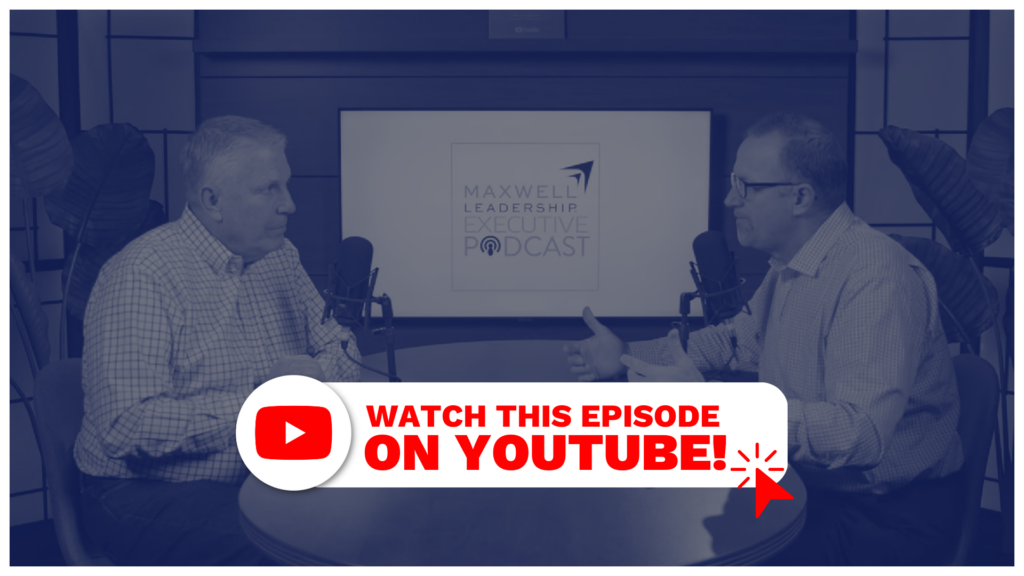Executive Podcast #249: How to Infuse Leadership In Your Team

Great leaders know that leadership is more caught than taught. Your team is watching you all the time and observing how you lead––both the good and the bad. How can you infuse leadership teaching in your team without sending everyone to a leadership development course?
Download our Learning Guide for this podcast!
Perry Holley:
Welcome to the Maxwell Leadership Executive Podcast, where our goal is to help you increase your reputation as a leader, increase your ability to influence others, and increase your ability to fully engage your team to deliver remarkable results. I am Perry Holly a Maxwell Leadership facilitator and coach.
Chris Goede:
And I’m Chris Goede. I’m executive vice president with Maxwell leadership. Welcome and thank you.
Perry Holley:
You said that authority too.
Chris Goede:
I love that. Well, I’m about to infuse some leadership into this. Fantastic. I am so excited about this. This is a practical podcast today about infusing leadership we talk about all the time, even us, where we go, we don’t have enough time to do this, we don’t have enough time to do that. And man, I’m super excited about some of the things that you’ve brought to the table to make it very practical for our listeners today. So I wanted to be very good.
Perry Holley:
It was very good, delivered.
Chris Goede:
Well, Jake’s probably going to edited it out, but that’s okay. As we get started. Just a reminder if you want to learn more about the five levels of leadership, whether it’s a delivery of a training for your team in person or virtual, we do a ton of virtual training, maybe even want to be coached through that content as a leader and where you’re at in your journey, I want you to visit Maxwellleadership.com/podcast. There you can fill out a form, you can leave us a question, maybe a comment about a future podcast that you would like for us to talk about. That’s always very helpful as Perry goes in and creates all of our content for us. Well, today’s topic, as I mentioned just a minute ago, we’re going to talk about how as leaders do we infuse leadership in our team. What does that look like? Some people, they’re not aware of it. They just don’t know what they don’t know. Some people don’t have time. We’re going to kind of talk through this. And I know this is something that you wanted to bring to our podcast listeners because you hear about it often.
Perry Holley:
Yeah, I was with a group of leaders and I wasn’t feeling the love. I wasn’t feeling like they thought there was a lot in it for them. They were doing a pretty good job. And then I thought one of your biggest roles as a leader is to develop more leaders. So I just asked a simple question. I said, if I went into your department without you and I asked the people on your team, are they leaders? Would they see themselves as leaders, or would they point to you as the leader? And all of a sudden people started looking at their shoes. Well, what do you mean? I go, yeah. I think that most people, especially in the United States, I know we’ve been trained that leadership is a position, it’s the title, and that’s what we’re looking at. And so I’m not the leader, you’re the leader. And I thought, you know what? I think we can do a lot to begin changing that mindset and help ourselves a lot along the way. But I wonder, why do you think that people on the team don’t think they’re leaders?
Chris Goede:
It is something that I’ve been working in John’s world for on and off now over 25 years, and it still baffles me that people are like, oh yeah, no, I’m not a leader. And I guess maybe it’s just because you and I have grown up in consuming this content about leadership as influence to where it doesn’t matter if it’s in the workforce, doesn’t matter if it’s in your community, it doesn’t matter if it’s in your home. You have influence over people, over individuals or not. Or not. That’s right. And so that’s how we define leadership. It’s not about the title, it’s not about the position. And that’s why we love and we really kind of unpack the five levels of leadership so much because the power of connecting with people, producing with people, and then developing people really increases your influence with them and doing it with the right motive. This is not a model. And not saying we’re saying, hey, you need to increase your influence so that then you gain. Right. It’s that motive of making sure it’s really pure, that it benefits the organization, it benefits the other person, and then it benefits you.
Perry Holley:
Third, when we talk about influence, I have to remind them that influence because we’re often talking about leading down, me the leader, influencing my team. But influence is 360 degrees. You lead down, of course, but you also lead up to your boss. I hope you’re influencing your boss and you lead across to your peers. Probably one of the most impactful pieces of influence you have is side to side, how you help and guide and participate with each other to do that. But we call it books have been written on leading from the middle, leading without a title. This is where the people on your team, they don’t have the title, but do they have the influence? And well, always think about the law of the lid, always teach this and it’s always law number one, because without this, the the 20 don’t matter. Is that your ability to lead? Let’s substitute the word influence. Your ability to influence will determine how effective you are. And I’m going to add in all of life that no matter where you are, home, work, community, if you have influence, you’ll be more effective, if you don’t, you won’t. And so the idea with me is that when I ask the leaders why they don’t teach leadership on their team, why they don’t infuse some leadership, what do you think the number one answer is?
Chris Goede:
I don’t have time to do that. What do you want me to do that? Yeah. I want to go back to what you said, just a minute ago because you were talking about no matter where you’re at, and you talked about places. You also talked just before that about no matter where you’re at in the organization. It’s so important to understand you still have influence. And I heard a little bit of excitement when you started talking about that because you’re so passionate about the 360 degree leader content. Matter of fact, you helped us with the coaching curriculum on that. That has been instrumental in leaders. And then this year, we’ve decided that we’re going to take our 360 degree training course for teams, and we’re going to redo that. We’re going to update, and you’re going to be leading that for us. And I think it’s a space that people sit in and they go, I am not a leader, and we’re going. It doesn’t matter the place, it doesn’t matter the position you are. Now, with that being said that people do tell us all the time. We just don’t have time to develop people to infuse leadership into other people. The other thing that they tell us is they just don’t know how to do that. And that’s understandable. And so what we’re going to talk about today is just some practical ways, very simple, but hopefully profound, if you will implement some of these ideas with your team.
Perry Holley:
Yeah, these are things that you and I have seen firsthand. We’ve witnessed it and seen the positive results. I wouldn’t bring it if I hadn’t seen it, but I love these creative ideas. And just before you think I can’t add one more thing to my calendar, these are things I think you can do with things that are already on your calendar, which we’ve talked about before. But number one that I really enjoyed seeing was John has a Daily Reader that came out. It’s called the Maxwell Daily Reader. 365 days, couple of paragraphs, two minutes, three minutes tops is what it would take to do that and to introduce this to your team. I thought maybe you would share how we’ve seen that used.
Chris Goede:
Yeah, let me talk about this. Just a couple of paragraphs. We’re not kidding. This is a coffee table size book, and it’s all on one page. So even if we said it was a one pager, you’re like, okay, that’s great. It’s going to take me seven to ten minutes to read it. No, it is simple. Point a paragraph or two and it’s out. And what I love about this is we have an organization that we have the opportunity and the privilege to partner with. That is all about production. I mean, it is about metrics. It is about KPIs. Every stand up meeting they have every morning, it is, what did we do yesterday? What are we going to do today? Where’s the numbers? And they began adding this Daily Reader into those conversations. And so not just the leader. Obviously the leader shows the way. Right? And they lead by example, but then they’ll pass us around their stand up meetings, and they’ll read that day’s clip and then talk about it right there. And then they dive into the metrics. What I love about this is we were on a conversation call, and you were on the call with me just recently, and the CEO of this organization was like, hey, I know you guys are doing some group coaching with some of our executives on a monthly basis, and it’s going really well. We have this practice of starting most meetings, not just our stand up, most meetings with the Daily Reader. Are you guys doing that on the group coaching call? I think we all got quiet. We’re like, no, we’re coaching leadership, right? We’re going through. He goes, I’d like for you to start doing that. And I was like, man, it means so much to them inside their organization, and it’s such a simple process, but it’s a great tool. So again, it’s a Maxwell Daily Reader. A small page. It’s a great way to start meetings, and they do it every single morning inside their organization with over 12,000 employees.
Perry Holley:
He also shared that the CEO, founder of the company, when they get on a call with him, they said they all show up. They all got their reader hanging nearby. Okay? They can say, Chris, could you read today’s reading? Yes, sir. Thank you very much. You do not want to get caught looking for your reader.
Chris Goede:
I think one of our coaches piped up and said, yeah, no, I’m coaching a leader that he was in one of those meetings and didn’t have a book. That will never happen again.
Perry Holley:
Yeah, I bought it on Kindle, so I have it on my iPad. I’ve got a copy on my desk. I can carry it with me on my phone. I’m ready if he calls on me to do that. Just encouraging you. If you don’t have daily stand up meetings, though, you could, at your once a week team meeting, have someone read the entry for that day or for something from that week. If you have them each reading it on Daily on their own, have them ask them, what was your favorite entry from this week? Just one person, just two minutes, three minutes, five minutes tops to review a leadership concept. And now you have infused a mindset of leadership into people that don’t have titles, but they’re leaders to do that.
Chris Goede:
Just keep it simple, right? We don’t have to get very philosophical. Just keep it simple and have conversations.
Maxwell Leadership Growth Plan:
Leaders, you know better than anyone that growth is essential if you want to make tomorrow better than today. But fitting growth into your calendar takes intentionality and self discipline. So let Maxwell Leadership help make your growth achievable. You’re invited to join thousands of worldwide leaders in using the Maxwell Leadership Growth Plan. The Maxwell Leadership Growth Plan provides you with convenient and easy to implement leadership resources, including video lessons from John Maxwell, all at your fingertips. Available in our Maxwell Leadership app or online, you’ll be coached by many well known leadership experts that will help you achieve your growth goals. You can even listen to this podcast right there in the app. Check it out for free today at Growth.MaxwellLeadership.com. That’s Growth.MaxwellLeadership.com.
Chris Goede:
The second one. This is a little bit of a shameless plug. We need you to listen to podcasts. Our podcast. Not necessarily our podcast, but a podcast. Maybe it’s something on a topic or a competence that you really want your team to improve on, to be aware of, to move the needle on and have them listen to that on their own time, whether they’re driving or exercising or lunch break or man, for that matter, even if it’s on the clock. And they can listen to a 30 or 45 minutes podcast. Ours is less than 20. So if you want to do that, but here’s the key to that, listen to it. But in your weekly meetings, spend the first ten minutes getting feedback from the team. Hey, what was your number one takeaway? What are your thoughts about that? How can we apply something in that podcast to what we’re doing here and just let the room drive that conversation? But then you’re beginning to infuse leadership development in the team by allowing them to listen to a podcast and then taking ten minutes out of the meeting. I promise you this, your meetings are not so effective that you can’t give up ten minutes. Matter of fact, our team probably wishes I’m not even going to ask you about our team meetings because you don’t even want to show up.
Perry Holley:
I know that’s my least favorite.
Chris Goede:
That’s the truth. There’s ten minutes that you can just, at the beginning, just say, hey, let’s talk about this. I wanted you to listen to it last week and do that. Podcasts are a great source to be able to do that.
Perry Holley:
I have one organization that we have group coaching with and their leader, they’re all dispersed. They’re not local, so they’re all over the United States. And the leader texts his takeaway, one takeaway from the podcast every day, every morning when he comes to the gym, he says he listens to us and then texts to the team and then tries to get a thread going with them. Again, not something added to his calendar. Just a moment of conversation starters to say, what are you hearing? What are you thinking? How are you doing that?
Chris Goede:
I just had this image that he’s going to be walking out of the gym after listening to this podcast, and he’s like, here’s my favorite thing about the podcast. They talked about me sending it to you. What do you all think about that? I see that coming down the road.
Perry Holley:
Number three. I’ve seen this one used, and actually, I think we did it here? Well, probably before I joined, but I’ve heard you and I knew each other before, but talking about the 21 Laws of Leadership, one law per month from the book. So the the way I’ve seen organizations do this is bought everybody a copy of the on Your team, a copy of the 21 Laws, one of John’s first bestsellers, and is still, I think, in the 25th year of that or more. And taking one law a month and then passing it around, letting people, somebody different teach it at the team meeting, again, ten minutes or less on this law. This is what it meant. Everybody should have read it so they can all speak into it. But again, just infusing leadership moments. And you’ve done that 21 Laws.
Chris Goede:
Yeah, we want to be inside our organization. We really want to live out what we do, and we want to be a product of the product. And so we did that. We went around 21 people, had ten minutes, and it was once a month. It took a little while to get through the and it almost became a competition of who was going to have a better presentation. So people started bringing in video clips and PowerPoints, and then it got a little longer than ten minutes. And so for those that went first compared to when we stopped, there was a big difference in the quality of the presentation. But what was really cool about it, and, you know, this is that, man, when you listen to a conversation or a lesson, you learn some things. When you prepare and teach it, you learn it tenfold. And so we had 21 different people inside the organization really comprehend that law at a different levels and impacted and infused leadership in them, but also added value to the team. And it was a lot of fun to do that. And so we would highly encourage the 21 Laws of Leadership, just from a book standpoint for you to go with your team. Number four. This is kind of saying in that same track, we have a ton of leadership teams that do a book club. In essence, not John’s Books. That’s great if they are, but all kinds of different but extreme ownership, I know, is a big one. You talk about different types of books depending on where the team is that year, that quarter, that focus, but it’s part of their conversation, and they have come prepared to discuss their thoughts around a chapter a month on that book. They’re not trying to weigh them down. I believe anybody could read a chapter a month back to some of your irreducible minimums, and then they talk about it. And it’s just a powerful way to talk about leadership in your meetings.
Perry Holley:
I like this one a lot. And they do jump between Patrick Lynchione, John Maxwell, any of the topic you find the topic that you like said, extreme ownership and jocko and life. And really there’s so much, but making it small, I can’t iterate this enough is that if you make it big, they will not do it. You will not do it. It gets burdensome. But I’ve kind of made my life motto. You talk about irreducible minimums was small things done daily, consistently over time, remarkable results. Small things done daily, consistently, over time, remarkable results. And I just know that these small things compound over time. You’ll think, well, we did five minutes of a daily reader. That can’t possibly mean anything, not today. But after six months, when you’ve done, I don’t know, 22 of the people start to notice. It starts to compound. These little, small, incremental things start to pile on for that.
Chris Goede:
I’ll tell you this, let me share this. I had the opportunity maybe a couple of weeks ago with one of the teams I have the privilege of being a part of with. I took 510 minutes and just talked a little bit about intent versus perception gap that we we talk about in the five levels of leadership. And I had some conversations in the last couple of days. People would come to me and be like, man, I really listened to what you said. I want to make sure that the way I received it and the perception of what’s going on was the intent behind it. And it was just me taking a podcast, a lesson that you and I’ve done, some training we’ve done, and just sharing that with the team. And now I see it coming back as part of our common language. So as you do that, what ends up happening is you build that common language within the team, their beliefs begin to change, and then you’ll see behavioral change around that leadership. So fantastic.
Perry Holley:
The last one we’ll share today, but I’m sure there are more to do this, but the ones that we’ve seen I just call this a Ted Talk review was one of the leadership that I work with, would go to YouTube and look for Ted Talks on a topic that was interesting to the team. Ted Talks are all 18 minutes or less. Have them watch that during a week and then on the weekly team meeting, be able to just share and do the back and forth for five to seven minutes. He said, not big, not heavy. But exposing people and asking people to invest a little in themselves, you have to invest 18 minutes during the week. You can watch three or four minutes a day to get that if you can’t do it at one sitting. But I just love that idea of putting powerful things in front of people. I know one guy was coaching with, he wanted something a little different. I could tell. And I said, what if I got Harvard Business Review articles? And I just started passing in him an HBR article and say, let’s talk about this on our next call. There’s all kinds of resources and tools that you can start to put in front of your team that will help infuse this idea that you can lead from wherever you are because it’s influence, not your position. And I just the question of thinking, would it be better if your whole team acted like a leader?
Chris Goede:
100%.
Perry Holley:
Would that be better or worse for you? 100%.
Chris Goede:
When you do that, there are going to be individuals on your team that maybe aren’t comfortable just responding to questions off the cuff. They’re going to process. They want to think. So what I want to encourage you to do, if you have some of those teams, some of those people on your team, maybe mix it up a little bit, maybe in this situation, in regards to the Ted Talk, that you assign the Ted Talk, and then you give them three questions to be thinking about here’s three sample questions that Perry provided for us that maybe you can just share these, and these are the questions that you go around and answer so that they have time to think about it and prepare for it. Number one, what was your number one takeaway from the lesson? We’ve shared that here. Number two, how does what you consumed in that talk or in that lesson, how does that impact or apply to you personally? And then number three, how what you consume, does it apply to our team or our organization? How do we get better because of that? And I think those are three great questions, simple questions, but you will have some people on your team that will not necessarily speak up. We want them to participate. So switch it up and give some of the questions ahead of time.
Perry Holley:
And I think giving it ahead of time is a secret there to do that. And I just can’t I said it once, but the magic sauce here is small, daily consistency, those types of things is what really that compounds into these great results.
Chris Goede:
Yeah. As we wrap up, just building off of that, the comment that I wrote down here was, this is simple but not easy. But with intentionality, it’s both simple and easy. And I think if you’re intentional about it as leaders with these just practical tips, it doesn’t have to be perfect. You’re not giving a speech to you’re not giving an address to the United Nations. Just start to your point. Just do some things small. They don’t have to be perfect. They can be practical. They can be conversation starters. And if you’re intentional about it, it’ll make a difference.
Perry Holley:
Just seems like you and I, you and I will read something, and then we start to share. What we just a big quad. You always ask it, what’s your number one takeaway? That’s where I got that from you. I thought you and I started talking about it. You see something I didn’t see because you’re in a different place than I am. I’m in a different place. So when you get 7810 people on the team talking about it in a three minute, five minute, seven minute segment of your team meeting, you might be surprised what other and you start harvesting these great truths that you might have even missed personally to do that. So I’m sorry.
Chris Goede:
No. One of my favorite things that we do when we’re with teams and we’re facilitating content or consulting with them as we go into breaks and I know, especially at the end of the day, we’ll have everybody go around the room. We have 20 people in the room. We say, what’s your number one takeaway from the day? I learned more from that than most of the time. What I learned from the entire day of either facilitating or listening or observing. Because to your point, everybody has a different optics and a lens to it, and they’re absorbing in a different way. They’re hearing things differently that I might just not hear. And so those are my favorite times of some of the trainings that we do is before we go to break, I’ll just sit back sometimes and there’s 20 people in the room. If we did it three times that day, all of a sudden, I’m going to have 60 different points and top ideas that I can then go back and kind of pick out which one was most impactful to me and work on that one.
Perry Holley:
Terrific. Well, hope you put some of these to work. And the again, if you’d like the Learner guide for this episode, learn more about our offerings or leave a question or a comment. You can do all that at MaxwellLeadership.com/podcast. We love hearing from you. Very grateful you’d spend this time. That’s all today from the Maxwell Leadership executive podcast.
To be a Successful Leader, You Need Feedback on Your Leadership.
We’re excited to announce our new and improved Organizational Effectiveness Survey (OES). The OES gathers feedback from employees to give leaders and management the knowledge and action plans needed to develop a more effective and productive work environment. Our new version measures 4 areas of your business: Leadership, People, Strategy, and Performance.













Be the first to comment on "Executive Podcast #249: How to Infuse Leadership In Your Team"